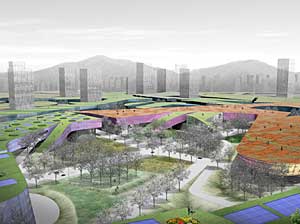Correction appended January 1, 2008
The word “sustainable” is not often used to describe the pollution-choked cities of Asia, but the continent is poised to host a new generation of green cities that right the wrongs of industrial-era urban planning. The question “Could we do better?” motivated New York-based SHoP Architects to take on one such project, the high-tech Sector 61 node of Gurgaon, India.



Balmori Associates' in-house studio Balmorilab teamed with Haeahn Architecture and H Associates to design the Public Administration Town district of Multi-Functional Administrative City in South Korea. Roughly 9.7 million square feet of buildings will be sheltered by a nearly continuous green roof, nestled into the landscape.
“We feel like if you can set a good example there, with all the building that’s about to occur, you can have a much bigger impact than designing some LEED Platinum building here in New York,” says SHoP co-founder Gregg Pasquarelli.
Sector 61 is one among a series of commissions in which internationally known designers are creating whole neighborhoods and cities to capture and direct Asia’s sudden urbanization. Other examples include the Shanghai satellite city Dongtan, designed by Arup, and the competition for a 1.6 million-square-foot eco-quarter in Singapore, recently won by Foster + Partners.
“The millions descending on Shanghai or Seoul depopulate the countryside and exceed the city’s capacity, with only one or two cities funneling the shift,” explains Diana Balmori, principal of the New York–based landscape and urban design firm Balmori Associates. “So the effort is to deploy this growth to some place, give this new city a reason to exist, and bring population to it.”
Balmori’s in-house studio Balmorilab also is participating in that effort. Its design for Public Administration Town (PAT) comprises one district within the larger ring plan for Multi-Functional Administrative City, located in South Korea halfway between the capital Seoul and Busan, on the south coast. President Roh Moo-hyun is establishing the city in order to transplant several government offices from the capital. Balmorilab, with Haeahn Architecture and H Associates, won the open competition to design PAT and several of its key buildings.
Although PAT is the ostensible downtown of Multi-Functional Administrative City, Balmorilab has given it a keenly anti-iconic character. Buildings, totaling approximately 9.7 million square feet, will be open to public movement and nestle into the existing topography to create a continuous roofscape. The flat plane, dotted with plants as well as photovoltaics, also expresses PAT’s commitment to sustainability; other green features include graywater recycling, titanium dioxide paving, and methane production from organic waste. “The city that uses living systems, rather than industrial-era systems, offers a better quality of life from day one,” Balmori says. Construction will start next summer, and the project should be largely completed within two years.
Sector 61, in Gurgaon, India, will also break ground next year. This former agricultural village is transforming into a dense corridor of high-tech office campuses and apartment buildings as growth spills over from New Delhi. The multi-use, privately developed parcel will accommodate 73,000 people. SHoP is designing all of its 100 buildings. Pasquarelli says the plan will stress sustainable strategies including solar orientation and pedestrian movement instead of the deployment of green technologies. “The cost of construction in India is so much less that to purchase Western technologies throws the entire budget out of whack,” he explains, adding that good planning can reduce carbon footprint more than technological supplements.
Whether Asia’s future cities go green thanks to technology or to more passive principles, the newest generation of planners acknowledge that predecessors such as Arup and William McDonough, FAIA—who is expected to make an announcement soon about his Chinese eco-cities projects—have established a green standard for their own work. What observers should expect from the next wave, says Balmori associate and landscape design director Mark Thomann, is “a formal approach to sustainability that’s really expressing itself.”
Correction: William McDonough + Partners has designed master plans for cities in China but has no plans for an announcement soon.





Post a comment to this article
Report Abusive Comment